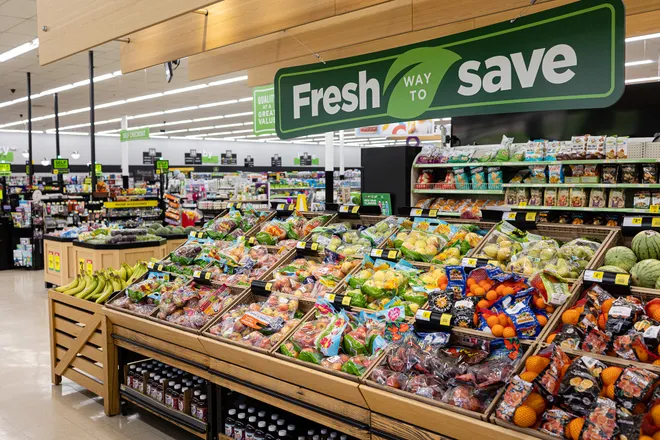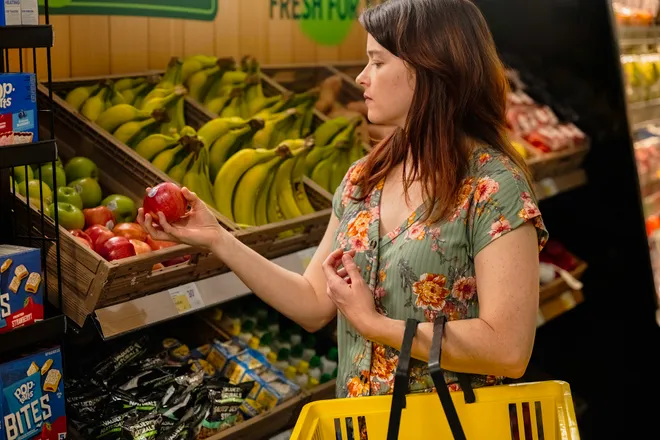Produce at the dollar store: Fruits and veggies now at 5,000 Dollar General locations, company says

Dollar stores are often associated with items such as greeting cards, candy and cleaning supplies. However in recent years, customers have noticed more and more of an essential item popping up: produce.
Dollar General is now offering fresh produce options in more than 5,000 stores across the country, the company revealed to USA TODAY exclusively. According to a news release from the company, this move would mean the retailer "has more individual points of produce distribution than any other U.S. mass retailer or grocer."
Produce has marked an area of expansion for Dollar General. In 2022, then-CEO Jeff Owen said on a company earnings call that fresh produce was sold in about 3,000 of its 18,800 stores, according to the Wall Street Journal.
Dollar General's produce offerings include tomatoes, onions, apples, strawberries, potatoes, lemons, salad mixes and more. The company told USA TODAY its stores now carry the top 20 items that would typically be sold in grocery stores.
The company announced it's "Food First" initiative in July 2023, which included the expansion of its private label brand, Clover Valley. The expansion saw over 100 new items introduced to Dollar General shelves, including entrees, sauces, condiments and more.
“We are constantly looking for ways to better serve our customers and one of our top priorities is to ensure the communities we call home have access to fresh, affordable, and convenient food options,” said Emily Taylor, executive vice president and chief merchandising officer at Dollar General.
Dollar General also said it recently invested in a partnership with Shelf Engine, an artificial intelligence company "providing retailers with technology to improve perishable food forecasting and ordering." According to the news release, the partnership will help "automate the ordering process while providing customers with the freshest food possible."

Communities pushing back against dollar stores opening in their town
Dollar General's expansion of produce comes after the chain and its dollar store competitors have faced blowback for what critics say is their contribution to food deserts. The stores are known for affordable prices on common goods, but have often lacked the variety of nutritious food options found at grocery stores.
In early 2023, the Institute for Local Self-Reliance published a report concluding that more communities were turning away from the prospect of a dollar store opening up in their town.
In the report, researchers said more than 70 cities and towns had already blocked new projects from chain dollar stores and 50 cities enacted laws to permit the discount retailers' plans for expansion. The three main retailers – Dollar General, Dollar Tree and Family Dollar, which is owned and operated by Dollar Tree – are some of the only retailers left in small towns and in rural areas, according to the report.
Dollar store opposition:Communities pushing back against dollar stores opening in their town, report finds
"One might assume that the dollar chains are simply filling a need, providing basic retail options in cash-strapped communities," the report said. "But the evidence shows something else. These stores aren’t merely a byproduct of economic distress, they are a cause of it."
Researchers said these tactics leave people without access to fresh food, further imposing hardship on residents who have to travel farther to buy food.
Representatives from the stores disagreed with the report.
"Dollar Tree and Family Dollar complement grocery stores and bring economic development to every community we enter, including helping to alleviate the effects of 'food deserts' in urban communities by helping serve those who would otherwise be limited in their access to the basic food items we provide," said Kristin Tetreault, chief communications officer at Dollar Tree, at the time.
Dollar General spokesperson Crystal Luce said at the time their stores are often sought to fill the gap in a time when the grocery industry is shifting.
According to its website, the ILSR is a national research and advocacy nonprofit focused on building up local properties and businesses.
Grocery prices have steadily risen since pandemic
Food prices have steadily risen since the beginning of the pandemic, thanks to a mix of inflation, supply-chain disruptions and an increased demand.
While inflation has come down from last summer's high, some Americans continue to feel the effects of price hikes at the grocery store. The average American household spends more than $1,000 per month on groceries, according to Census Bureau's Household pulse survey. But that number varies depending on where you live and how many family members you're feeding.
Grocery prices:Who spends the most on groceries each week (and who pays the least)? Census data has answers
The average family spends about $270 at the grocery store per week, but that number increases when children are taken into account. Families with kids spend an average of $331 a week on groceries or 41% more than families without kids.
California was at the top of the list for most expensive places to buy groceries, with the average household purchasing $297 worth of groceries per week. Neighboring state, Nevada follows closely behind with the average household spending $294 a week.
Contributing: Amritpal Kaur Sandhu-Longoria & Sara Chernikoff, USA TODAY

Disclaimer: The copyright of this article belongs to the original author. Reposting this article is solely for the purpose of information dissemination and does not constitute any investment advice. If there is any infringement, please contact us immediately. We will make corrections or deletions as necessary. Thank you.







